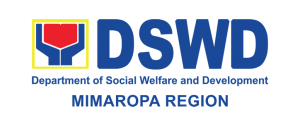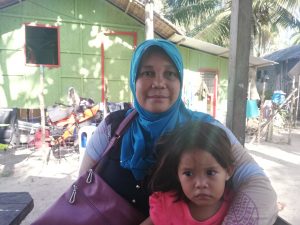
For the longest time, Diana Abdula, 33, haven’t thought that her feet would be able to step on a hard concrete wharf in their far flung barangay in Balabac, Palawan. For the longest time, there’s no other way out but a 100-meter walk over a creaking – sometimes slippery – rickety wooden wharf under the scorching heat of the sun in summer or the cold needle-like piercing of raindrops during rainy days.
But Abdula, and the rest of the community members, proved that the people have the power to make their lives better.
For a short while now, the 100-meter stretch of hard cement stands proud and mighty – as if announcing to every person who alights from the passenger boats that it is a product of sweat, passion, and hardwork of the Muslim community of Brgy. Bancalaan, Balabac, Palawan.
The Wooden Wharf
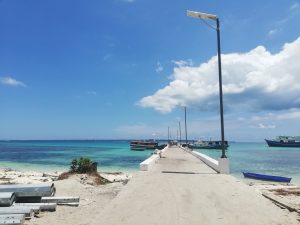
The island municipality of Balabac is considered as the westernmost point of the Philippines, just a few kilometres away from Sabah, Malaysia. Due to its geographical location, it has long been deprived of easy access to government services and opportunity for growth and development.
To say that the journey to Balabac is rough is an understatement. One has to leave capital city Puerto Princesa in the wee hours of the morning – 2AM is safe, 4 AM is a risk – to travel 272.5 kilometers away to Rio Tuba in the municipality of Bataraza. From there, two passenger boats depart daily at around 11:30 AM.
But the beauty of the municipality is worth the whole day travel. Balabac is home to unspoilt long-stretch of white sand beaches and pristine clear waters.
So it has not been a surprise that this paradise is increasingly gaining attention from local and foreign tourists alike.
For the past years, however, the first thing that welcomed tourists to the municipality was a wharf made of wooden boards. The boards, which were around two inches apart, paved the way to reach the island after more or less 3 hours of sailing along Sulu Sea and Balabac Strait.
Safety, as expected, wasn’t guaranteed.
“Yan dati kahoy lang s’ya, so madalas yung maintenance, madalas masira. Nasa tabing-dagat kasi ‘yan, ‘pag yung pako kinalawang na, automatic ‘yun, luluwag na. Pag lumuwag na, makakalas na yung mga tabla tabla, tapos madalas, may mga nahuhulog, nalulusot (Before, the wharf was made of wooden boards, so the maintenance was frequent. Since it was near the shore, nails become rusty easily. When that happens, the wooden boards would then be unusable,and there were incidents of people falling down the holes),”said Rolly Reyes, Brgy. Captain of Bancalaan.
Maintenance cost for the wooden wharf was also a problem for the barangay due to frequent retro-fitting.
“Kapag may nasira doon, nabulok ang kahoy, di naman pwedeng ang papalitan mo yun lang, kailangan totally buuin mo lahat kasi mabilis lang din masisira (When one wooden board gets damaged, we couldn’t replace that specific board alone. So we usually overhaul the whole wharf or at least large segment of it),” he added.
The wooden boards, moreover, were bought from mainland Palawan adding more logistical costs. The price of the boards alone was estimated at around PHP 1,000 per piece. Add the transportation cost and the price ballooned to an amount that took its toll to the budget of the barangay.
Cementing the wharf, Cementing progress
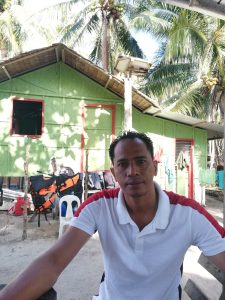
Home to 14,500 individuals, around 99% of whom are Muslims, Brgy. Bancalaan is composed of two islands. The wharf, which costs PHP 4,831, 623. 79, is situated in the major island is considered as the entry point to Balabac.
For Brgy. Captain Reyes, this wharf serves as the face of the municipality, giving tourists their first impression of what Balabac is and what it has to offer.
So when the Kapit-Bisig Laban sa Kahirapan – Comprehensive and Integrated Delivery of Social Services (Kalahi-CIDSS) of the Department of Social Welfare and Developmemt (DSWD) reached their municipality, the people of Bancalaan did not think twice on proposing a better, and definitely safer wharf.
Not only does this new wharf look so much better, but it also helps in the economic development of this far-flung community.
The 100 linear meter concrete wharf, completed on May 2019, eases some economic burden to the residents of Bancalaan. For the longest time, they would pay the porters Php 30.00 per sack of goods that has to be carried across the wooden wharf up until it reached the beach area.
Abdula, born, raised and eventually started a family in Bancalaan, recalled how hard and expensive it has been for them to transport goods from neighboring town Bataraza to their barangay.
“Kapag galing pa sa Rio Tuba, namasahe ka na sa passenger tapos nagpa-estiba ka pa d’yan tapos namasahe ka pa sa motor. Kaya medyo mahal ang paninda dito (From Rio Tuba, you’ll pay for the passenger boat fare and then for porter services and then for tricycle. So the goods sold here are relatively more expensive than normal),” said Abdula.
Involving the community, Creating a legacy
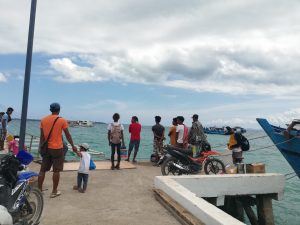
If Brgy. Bancalaan is the heart of Balabac, the community volunteers are considered as the heart of the barangay.
If not for them, we wouldn’t be able to step on a wharf made of hard concrete, said Brgy. Capt. Reyes.
The first-termer Brgy. Captain believed that the community’s involvement in the process of project development – from planning to implementation – has contributed a lot to the completion of the wharf which benefits all of the residents of barangay, neighboring barangays, and even tourists that are starting to flock their municipality.
“’Pag involved ang tao syempre mas aalagaan nila ang proyekto, ‘pag involved ang tao, concerned sila, ‘pag may nakita silang [mali], may mag-rereact. Kasi syempre, merong makikialam, merong makikiisa, ‘yun ang advantage talaga pag involved [ang community]. Saka sa lahat ng proyekto, ‘yun ang tama, involve mo ung community (When the community is involved, they would definitely take care of the project, they are concerned so when they see something odd, they would react. There are people who would show no indifference, who would cooperate; that’s the advantage of community involevement. And that’s the right thing to do in project development),“ said Brgy Capt. Reyes.
In the Kalahi-CIDSS process, the beneficiary community are in the frontline. Community volunteers are chosen to execute the processes needed for project completion. Decisions for them are made by them. For Brgy. Captain Reyes, this has led to the community’s sense of ownership over the wharf.
“Amin ‘yan. Kami ang gumawa n’yan. Pinaghirapan namin ‘yan. Involved kami d’yan. Alaala namin ‘yan (That’s ours. We made that. We exerted effort for that. That’s our legacy),” he added.
From now on, for a very long time, the legacy of the volunteers of Brgy. Bancalaaan will surely be of great use to the community. The wharf, created with passion, vigor, and the undying hope to make life in the island easier, will let this generation – and the ones that will follow – boar the passenger boats safer and free of worry. #
![]()


